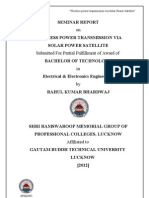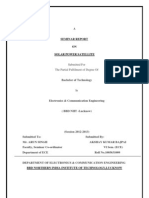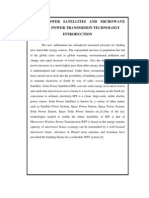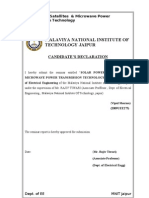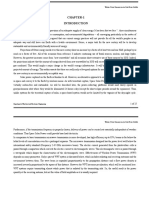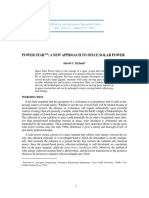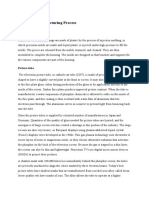Golap 2014 PDF
Golap 2014 PDF
Uploaded by
golapkantideyCopyright:
Available Formats
Golap 2014 PDF
Golap 2014 PDF
Uploaded by
golapkantideyOriginal Title
Copyright
Available Formats
Share this document
Did you find this document useful?
Is this content inappropriate?
Copyright:
Available Formats
Golap 2014 PDF
Golap 2014 PDF
Uploaded by
golapkantideyCopyright:
Available Formats
3rd INTERNATIONAL CONFERENCE ON INFORMATICS, ELECTRONICS & VISION 2014
Multi-Junction Solar Cells and Microwave Power
Transmission Technologies for Solar Power Satellite
Golap Kanti Dey, Kazi Tanvir Ahmmed
Department of Applied Physics, Electronics and Communication Engineering,
University of Chittagong, Chittagong-4331, Bangladesh
d.k.golap@gmail.com, tanvir@cu.ac.bd
Abstract Solar power satellite (SPS) is a renewable and infinite
energy system in the Geostationary Earth Orbit, which works as
an electric power plant in space. Main theme of our research
work is that SPS will collect solar energy, converts sunlight to
electricity and beam the power to ground-based receiving
stations. The attenuation that results from passing through the
atmosphere, sunlight in Earth orbit is about 25% more intense
than on the ground. Four main parts of microwave power
transmission (MPT) for Solar power satellite system are- highly
efficient solar cell for space solar panel, a microwave generator
(for high power application magnetron can be used and for low
power application we can use solid state amplifier), an antenna to
transmit microwave power, and a rectenna to receive and convert
the microwave energy into usable DC power. With the increases
in energy cost and recent interest in finding ways to produce
energy with reduced emission of greenhouse gasses, SPS can play
a vital role. The ultimate concentration of this research work is to
introduce Solar Power Satellite system with multi-junction solar
cell which enhances overall efficiency of space solar panel and
modern technologies associated with MPT for proposed SPS
system.
Keywords- Multi-junction solar cell, phased array antenna,
rectenna, retrodirective system etc.
I. INTRODUCTION
The Sun is a very powerful, clean and convenient source of
power, particularly for human being. Solar Power is totally
free from any kinds of emissions, including carbon dioxide.
According to an increasing world-wide energy demand in the
21st century and of a need for a clean energy source, humanity
desperately needs assured, reliable, 24/7, economical energy
sources and for that purpose Solar Power Satellite (SPS)
concept has been explored by scientists and engineers. Space
based solar power can provide a clean inexhaustible
alternative energy of our universe. Widely acknowledged as
physically feasible but economically inconsistent, interest in
SPS has arised in recent years as a pursuance of rising media
attention ensuing from government and non-governmental
organization reports and national space agencies to enhance or
reinforce the improvement of practical Solar Power Satellite
systems.
Thanks to Peter Glaser [1] who first proposed SPS systems in
1968 in a conceptual design in which the SPS was placed in
geosynchronous orbit and the energy beamed to a land site
using a microwave beam. U.S. Department of Energy (DOE)
and the NASA during the late 1970s [2] developed an initial
understanding of the technical feasibility, the economic
practicality, and the social and environmental acceptability of
the SPS concept. In 1981 Corson [3] did research work on
how to sent electric power from orbit, after that again by
NASA in 1995 and 1999 in the form of the Fresh Look
study [4] and Space Solar Power Exploratory Research and
Technology (SERT) program [5],conducted their study
respectively. European Space Agency [6], Japanese Space
Agency (JAXA) [7], International Union of Radio Science
(URSI) [8], U.S. National Security Space Office (NSSO) [9],
the U.S. Naval Research Laboratory (NRL) [10] also did their
investigation about space based solar power system. Most
recently Vaibhav.R [11] also did his research work on efficient
power conversion and beam control for SPS application .
Komerath, N. [12] worked on a giga-byte level SPS system.
Reference [13] worked on statistical model of the total needed
power for the satellite and mass of energy providing
subsystem. Besides several investigation and research works
are also conducting now-a-days by space agencies and laureate
researchers. Though several researchers have been
investigated on SPS, however, further research considering
competent highly efficient solar cell for space solar panel and
highly efficient microwave power transmission modules still
needed.
In our research work we will investigate about three layer
multi-junction solar cell for space solar panel which increase
overall efficiency rather than one or two layer of solar cell.
Besides, we will explore highly efficient phased array antenna
for microwave power transmission with efficient transmitter
for SPS system such as Magnetron. Almost all of the SPS
models proposed so far use microwave rather than laser for the
wireless power transmission, because the power efficiency
both at the transmitter and receiver is generally higher and
attenuation through the atmosphere is lower for microwave as
978-1-4799-5180-2/14/$31.00 2014 IEEE
3rd INTERNATIONAL CONFERENCE ON INFORMATICS, ELECTRONICS & VISION 2014
compared with laser. We will also deploy the retrodirective
system for beam control. For receiving micrrowave power and
for converting to DC, rectenna which is composed of
rectifying circuit and antenna will be used here.
h
So the basic
principle is that highly efficient multi-junnction solar cells
involved with SPS system will collect solar energy which will
be transmitted as microwave power thrrough appropriate
phased array antenna. In the receiving site rectenna
r
will catch
the microwave power. After rectification process
p
as well as
after DC to AC conversion coollected solar power from space
will be connected to the power grid.
After taking consideration all of
o above mentioned modules we
can devise a SPS system whichh may use as substitute source of
energy rather than using coal, gas,
g oil etc. at the same time will
keep away the world from the paws
p
of global warming created
by the burning of carbon fuels.
Figure 1. Block diagram of proposed space based solar power system, consisting of solar power satellite and ground parts
II.
III-V MULTI-JUNCTION SOLA
AR CELLS
III-V semiconductor materials show high effficiencies matched
by no other existing photovoltaic technoloogy. That is why
Multi-junction solar cells normally fabriccated from these
materials. Multi-junction solar cells are conssists of 3 layers of
material that have different bandgaps. The top layer has the
largest bandgap though the bottom layer has the smallest
bandgap. This kind of design consideraation allows less
energetic photons to cross the upper layer(s) and be absorbed
by a lower layer, which enhances the overalll efficiency of the
solar cell. One significant design consideration is that the
photocurrent produced in each layer must be the equal [14]
since the layers are in series. For the efficiennt absorption of the
spectrum of incident radiation, the bandgaaps of each layer
should differ by nearly equal energies. Although multijunction solar cells are very effective, thhey are also very
expensive.
h
been studied.
Since 1960 [15] multi-junction solar cells have
The first multi-junction device, in early 19800s, converted 16%
of the solar energy into electricity [16].US
[
National
Renewable Energy Laboratory (NREL) brokke the 30% barrier
in 1994. A present-day record 40.7% efficieency was achieved
with a triple-junction version of the cell [177]. The maximum
theoretical limit efficiency of multi-junctiion solar cells is
86.8% [18].Besides, recently in late 2013 German
G
Fraunhofer
Institute for Solar Energy Systems, Soitec, CEA-Leti and the
Helmholtz Center Berlin announced that in the lab they have
achieved an efficiency of 44.7% [19] for the conversion of
sunlight into electricity using IIII-V multi-junction solar cell.
A. Bandgaps
For the maximization of convversion efficiency the solar cell
should be designed in the way so that it can absorb as long of
the spectrum as possible, and so bandgaps be able to cover a
wide range. In addition, bandggaps of adjoining layers should
differ by as small amount as possible,
p
because the amount of
excess energy from light connverted to heat is equal to the
difference between the photonn energy and the bandgap of the
absorbing material.
B. Lattice Constants
The lattice constant describes the spacing of the atom
locations in a crystal structure.. Mismatch in the crystal lattice
constants of different layers crreates dislocations in the lattice
of the cell layers and significaantly deteriorates the efficiency
of the solar cell. In the figuure 2 the lattice constants and
bandgap energies of commonn semiconductor materials are
shown. Lines between different
d
materials represent
semiconductors that can be created
c
by combining different
amounts of the two materialls. Ge, GaAs and AlAs have
roughly the same lattice constaant with different bandgaps, and
compositions of these materiaals are currently used to create
high-efficiency triple-junction cells
c
[20].
978-1-4799-5180-2/14/$31.00 2014 IEEE
3rd INTERNATIONAL CONFERENCE ON INFORMATICS, ELECTRONICS & VISION 2014
C. Current matching
The fabrication of monolithically-grown multi-junction solar
cells makes matching of currrents a desirable characteristic
[14]. As the layers are in the series
s
the currents through each
of the subcells are imposed to have the same value. The
current is directly proportionnal to the number of incident
photons exceeding the semicconductors bandgap, and the
absorption constant of the maaterial. A layer must be made
thinner if the photons that exceed the bandgap are in
abundance. At the same time,, a layer with a low absorption
constant must be fabricated thhicker, as on average a photon
need to pass through more of the material before being
absorbed.
III. MICROWAVE POWER TRANSMISSION FOR SPS
Figure 2. Ternary and quaternary III-V compounds reelation between lattice
constant and bandgap [20].
Now-a-days the most efficient multi-juncction photovoltaic
cells [21] are made of GaInP, GaAs, and Ge layers on Ge
substrate. The first layer of this recordd-breaking cell is
composed of GaInP (1.85 eV), converting short wavelength
portions of spectrum, such as blue and UV, the second GaAsa the third layer
layer (1.42 eV) captures near-infrared light, and
is made of Ge, effectively absorbs the loweer photon energies
of the IR radiation that are above 0.67 eV [22]. The principal
u
containing
scheme of such a triple-junction solar cell, usually
about 20 layers, is shown on Figure 3.
After compromising between thhe antenna size and atmospheric
attenuation, microwave frequenncy for the SPS system is taken
to be in the range of 16 GH
Hz. For higher frequencies, the
scale of the transmitting/receivving antenna can be smaller and
the ionospheric plasma interraction is less, but the rainy
attenuation becomes larger. Iff we choose a frequency in the
industrial, scientific, and meddical (ISM) radio bands, then
either 2.45 or 5.8 GHz woulld be a potential candidate. A
frequency of 2.45 GHz was ussed in the early phase study, but
considering the recent progresss in the C-band RF technologies,
5.8 GHz is considered to be a more
m
favorable frequency to use.
This is clearly illustrated by the
t reference designs that have
been generated over the last deecade or so, primarily by JAXA
and NASA, showed in Table 1.In
1 this table JAXA stands for :
Japan Aerospace Exploratioon Agency, NASA: National
Aeronautics and Space Addministration and DOE: U.S.
Department of Energy.
TABLE I. Typical Parameters of Various
V
GEO-Based SPS Concepts [24]
Figure 3. Structure of a triple-junction photovolttaic cell [23].
978-1-4799-5180-2/14/$31.00 2014 IEEE
3rd INTERNATIONAL CONFERENCE ON INFORMATICS, ELECTRONICS & VISION 2014
mission
A. Antennas for Microwave Power Transm
All kinds of antennas as for example, dipoles [25], Yagi-Uda
antenna, microstrip antenna, parabolic anteenna [26], phased
array antenna can be applied for both the MPT system and
communication system. For the fixed tarrget of the MPT
system, we can select a large parabolic antennna. However, we
have to use a phased array antenna for the MPT because we
have to control a microwave beam directtion precisely and
quickly. All SPS is designed with the phased array antenna
The phased array is a directive antenna whicch generate a beam
form whose shape and direction by the reelative phases and
amplitudes of the waves at the individual antenna elements.
However, it is quite possible to manage thhe direction of the
microwave beam. Phased array antenna was adopted to
manage the direction of the microwave beaam in some MPT
experiments in Japan (figure-4).
Figure 4. The SPRITZ project conducted in FY2000, demonstrating the
phased array developed for the SPS application [27]
B. Magnetron
Employed technology for the production of microwave
radiation is a highly significant subject foor the Microwave
Power Transmission system. Highly efficientt generator as well
as an amplifier is needed for the MPT systeem rather than the
normal wireless communication system.. Magnetron[28],
which is a crossed field tube. In the magnnetron forces
electrons emitted from the cathode to take cyclonical path to
the anode. Magnetron is also known as thhe self-oscillatory
device where the anode contains a resonannt RF structure. It
was W. C. Brown who invented a voltage coontrolled oscillator
(VCO) with a cooker-type magnetron in a phase
p
locked loop
[29]. He could control and stabilize a phaase of microwave
emitted from cooker-type magnetron. Att present, several
research groups attempt and succeed to develop new
magnetron system through which we can coontrol and stabilize
a phase of microwave emitted from cookeer-type magnetron
[30]-[32]. A phase and amplitude conttrolled magnetron
(PACM) has been developed at Kyoto Univversity, Japan [33].
They were succeeded to control beam direcctions and phased
arrays with phase controlled magnetrons opeerated in 2.45 GHz
and 5.8 GHz (Figure-5).
Figure 5. Block Diagram of PACM [34]
Besides, weight of the microwave tube (such as magnetron) is
lighter than that of the semiiconductor amplifier when we
compare the weight by pow
wer-weight ratio (kg/kW). The
microwave tube can gennerate/amplify higher power
microwave than that by the semiconductor amplifier.
Researchers of Kyoto Univeersity have developed a light
weight phase controlled magnetron called Compact
Microwave Energy Transmitteer (COMET) [35] with a powerweight ratio below 25g/W.
C. Retrodirective Target Detection and Beam Control
u of transmitting and receiving
A retrodirective system made up
antennas and with a phasee conjugate circuit. A signal
transmitted from the target (heere from the rectenna site on the
ground to the SPS),is receiveed and re-radiated through the
phase conjugate circuit to the direction
d
of the target. The signal
is called a pilot signal. There are
a two types of phase conjugate
circuits for SPS. One has two
t
asymmetric pilot signals,
+ and
+2 , and thhe Local Oscillator (LO) signal
of 2
(Fig. 6 (a)). Another onne is pilot signals with one third
of the transmitting frequency and the LO signal is generated
from the pilot signals (Fig.6 (b))).
Figure 6. Phase connjugate circuits
In order to maintain the maxximum transmission efficiency,
retrodirective rectennas [36] are
a desirable due to their ability
to maintain main-beam aliggnment between transmit and
receive antennas. There are multiple techniques used for
a
These techniques involve
implementing a retrodirective array.
a pilot signal being sent from thhe receive array (in this case the
rectenna array) back to the transmitter. In addition, the
p
level for the pilot signal
frequency, polarization, and power
will need to be determined as well.
w
978-1-4799-5180-2/14/$31.00 2014 IEEE
3rd INTERNATIONAL CONFERENCE ON INFORMATICS, ELECTRONICS & VISION 2014
D. Rectenna System
The word rectenna stands for rectifyying circuit and
antenna. It was invented by W. C. Brow
wn in 1960s [37].
The rectenna[38] can receive and rectify a microwave power
to DC. The receiving aperture in sppace based solar
power(SBSP) systems using microwave pow
wer transfer will be
an extremely large array of rectifying anteennas (rectennas).
Figure 7 is a schematic view of a rectenna. The
T incident wave
is received by the antenna and coupled to thee rectifying circuit.
In this case, the rectifying circuit is indicatedd as a single diode.
The selection of the proper rectifying circuiit is usually based
on the incident power density and operationaal frequency range.
The output of the rectifying circuit passes thhrough a low pass
filter (LPF). The LPF is present to restrict anny RF energy from
flowing into the power management circuuit. The controller
circuitry enables the energy storage and thhe delivery of the
output DC energy [39]. The average RF
F power over the
operational frequency range of the rectenna at a given instant
wer received by the
in time is given by equation (1). The RF pow
antenna is a function of the incident poower density (S),
effective area of the antenna (
), inciidence angle, and
frequency
Figure 7. Schematic of rectenna and associated poweer management circuit
[39]
The DC power can be calculated from equaation (2), and it is
seen to be a function of the RF power, connversion efficiency
(), and the DC load impedance (
). The conversion
efficiency is known to be a function of thee input RF power.
Therefore, fluctuations in the incident powerr density will alter
the conversion efficiency and subsequenttly the output DC
power of the rectenna [39].
PRF(t) =
1
f high f low
fhigh
flow
S(,, f , t ) Aeff
e (,, f ) d df
PDC = PRF ( f i , t ) (PRF ( f i , t ), , Z DC )
..(1)
..(2)
mines the RF-DC
The circuit, especially diode, mainly determ
conversion efficiency. Silicon Schottky baarrier diodes were
usually used for the previous rectennas. New
N
diode devices
like SiC and GaN are expected to increase the
t efficiency. The
rectenna using the active devices is not passsive element. The
world record of the RF-DC conversion efficiency among
developed rectennas is approximately 90% att 4W input of 2.45
GHz microwave [40]. Other rectennas inn the world have
approximately 70-90 % at 2.45GHz or 5.8GHz microwave
t rectenna with a
input. The RF-DC conversion efficiency of the
diode depends on the microwave power inpuut intensity and the
connected load. It has the optimum microw
wave power input
intensity and the optimum load to acchieve maximum
efficiency.
Figure 8. Typical characteristic of RF-D
DC conversion efficiency of rectenna
[41]
When the power or load is not
n matched the optimum, the
efficiency becomes quite low (Figure 8). The characteristic is
determined by the characteristic of the diode. The diode has its
own junction voltage and brreakdown voltage. If the input
voltage to the diode is lower than the junction voltage or is
higher than the breakdown volltage, the diode does not show a
rectifying characteristic. As a result, the RF-DC conversion
efficiency drops with a low
wer or higher input than the
optimum.
IV. FRIIS TRANSMISSION EQUATION
E
FOR WIRELESS
POWER TRANSMISSION
m space to Earth in the form of
Beaming of Solar Power from
microwave energy is quite chaallenging to many disciplines of
engineering as well as for physics.
p
From the point of an
electromagnetic stand, this taskk shows many challenges which
are addressed ranging from, buut not limited to, array size (both
in space and on the ground),atm
mospheric losses, power density
of the transmitted beam on the Earths surface and beam
accuracy. If farfield conditions are assumed then the link
budget from Geostationary Earrth Orbit to a rectenna located on
Earth surface can be determinned using the Friis transmission
equation. However, high traansmission efficiency can be
obtained if the aperture sizes annd beam shape are selected such
that the transmitting and receivving apertures satisfy the Fresnel
Near Field conditions. The pow
wer received at the ground from
a transmitting array in geostaationary orbit can be obtained
from the Friis transmission eqquation (3).The power collected
by a receiving array having effective area of
from the
g
by the source radiance L
transmitting solid angle is given
and the geometric throughput as seen in equation -3.
= L
(3)
V. ISSUES RELATED WIT
TH PUBLIC ACCEPTANCE
High Power density microwave beams can do serious harm to
human life, plants as well as to wild animals. The dam lake
and offshore site have been connsidered as perfect locations for
the power receiving station on the ground for SPS. In the case
mmercial SPS, the power density
of the typical 1-GW class com
is expected to be 1 kW/
at the
t center of the beam having a
diameter of 3.5 km [42]. For
F
the safety of microwave
radiation, the ultimate intention is to control the inside of the
microwave beam as a confineed area in which people are not
allowed. The power density outside the restricted area is
planned to be kept well beloow the regulatory value of 10
W/
[42]. For the accepptance of mass people, the
electromagnetic effects on thee communication infrastructure
and radiation effects inside the
t
beam on the all kinds of
animals need to be assured to be below the acceptance level,
before execution of Solar Poweer Satellite system.
978-1-4799-5180-2/14/$31.00 2014 IEEE
3rd INTERNATIONAL CONFERENCE ON INFORMATICS, ELECTRONICS & VISION 2014
VI. CONCLUSION
In the 21st century people are now seeking sustainable source
of energy for highly efficient solution of increasing demand of
power, to get rid of emission of green house gases and to
alleviate burning of fossil fuels. Various new technologies are
now being researched. One of the most promising and
technically challenging of these is Space-based Solar Power
Satellite. Unlike solar power on the ground, solar power
satellites would not be pervious to cloudy days or the changes
of seasons in the geostationary Earth orbit (GEO). So obvious
result is that, we will get continuous solar energy to meet the
needs of our society. Collection of virtually boundless energy
of the sun available in space and beaming this power
downward to provide electrical power for use on the Earth
may also be a perfect replacement of risky and hazardous
Nuclear Power Plant. But the absolute challenging areas for a
SPS system are High Efficient solar cells for the space solar
panels and microwave power transmission technologies
(MPT).Although it will be highly expensive to launch Solar
Power Satellite system, it is asserted that SPS system will
reduce highly demandable power crisis for the developing
country as well as for the world.
REFERENCES
[1] P. E. Glaser, Power from the sun: Its future, Science, vol. 162, pp. 867
886, 1968.
[2] DOE/NASA Satellite Power System Concept Development and Evaluation
Program, Satellite Power System (SPS) FY 79 Program Summary,
Washington, DC, USA, DOE/ER-0037, 1980.
[3] D. R. Corson, N. M. Bradburn, M. Chodorow, J. J. Dougherty, W. E.
Gordon, B. M. Hannon, K. P. Heiss, C. J. Hitch, D. F. Hornig, C. G. Little, J.
R. McDonald, L. C. Meeker, T. O. Paine, C. K. N. Patel, and R. B. Setlow,
Electric Power from Orbit: A Critique of a Satellite Power System, National
Academy of Sciences, Washington, DC, USA, 1981, ISBN:0-309-03183-4.
[4] J. C. Mankins, A fresh look at space solar power: New architectures,
concepts and technologies, presented at the 38th Int. Astronaut. Federation,
Brighton, U.K., IAF-97-R.2.03, 1997.
[5] Committee for the Assessment of NASAs Space Solar Power Investment
Strategy, Aeronautics and Space Engineering Board, National Research
Council, Washington, DC,USA,Laying the foundation for space solar
Power: An assessment of NASAs space solar power investment strategy,
ISBN: 0-309-07597-1, 2001.
[6] Earth & space-based power generation systems VA comparison
study,Contract 17682/03/NL/EC to ESTEC,2005.
[7] M. Moria, H. Nagayamab, Y. Saitob, and H. Matsumoto, Summary of
studies on space solar power systems of the National Space Development
Agency of Japan, Acta Astronaut., vol. 54, pp. 337345, 2004.
[8] Report of the URSI Inter-Commission Working Group on SPS, URSI
Inter-Commission Working Group on SPS, 2007.
[9] National Security Space Office, Space-based solar power as an
opportunity for strategic security,Washington, DC, USA, Phase 0
Architecture Feasibility Study, Release 0.1,2007.
[10] W. N. Johnson, K. Akins, J. Armstrong, K. Cheung, G. Henshaw, S.
Huynh, P. Jaffe, G. Kirby, M. Long, M. Mook, M. Nurnberger, M. Osborn, R.
Skalitzky, F. Tasker, J. Dahlburg, M. N. Lovelette, R. Bartolo, K. Williams,
M. Dorsey, D. Gubser, P. Jenkins, F. Kub, B. Levush, S. Messenger, J. Pasour,
R. Walters, N. Smith, W. Boncyk, M. Brown, and D. Huber, Space-based
solar power: Possible defense applications and opportunities for NRL
contributions, Washington, DC, USA, NRL/FR/765009-10,179, 2009.
[11] Vaibhav.R, S.Sai Bharathwaj, Wireless Power Transmission with Solar
Power Satellite, International Journal of Inventive Engineering and Sciences
(IJIES) ISSN: 23199598, Volume-1, Issue-11, October 2013.
[12] Komerath, N. ; Dessanti, B. ; Shah, S.A Gigawatt-Level Solar Power
Satellite Using Intensified Efficient Conversion Architecture,2012 IEEE
Aerospace Conference, pp. 1-14,2012.
[13] Mirshams, M. ; Zabihian, E. ; Zabihian, A.R.Statistical model of power
supply subsystem Satellite, 6th IEEE International Conference on Recent
Advances in Space Technologies (RAST), pp. 665-669,2013.
[14] G. P. Smestad, Optoelectronics of solar cells, Bellingham, WA: SPIE
Press, 2002
[15] M. Wolf, Limitations and possibilities for improvement of photovoltaic
solar energy converters, Proc. Inst. Radio Engineers, vol. 48, 1960.
[16] Handbook of photovoltaic science and engineering, ed. by Antonio Luque
and Steven Hegedus, 2003.
[17] Spectrolab solar cell breaks 40% efficiency barrier, December 7, 2006,
http://www.insidegreentech.com/node/454/(Accessed 20 January 2014 )
[18] F. Dimroth, 3-6 junction photovoltaic cells for space and terrestrial
applications, Photovoltaic Specialists Conference, 2005.
[19] http://www.soitec.com/en/technologies/concentrix/components/(Accessed
20 January 2014 )
[20] J. M. Romn, State-of-the-art of
III-V solar cell fabrication
technologies, device designs and applications, Advanced Photovoltaic Cell
Design, 2004.
[21] F. Dimroth et al., Next generation GaInP/GaInAs/Ge multi-junction
space solar cells, Proc. 17th Photo-voltaic European Conference, 2001.
[22] R. R. King, Bandgap engineering in high-efficiency multijunction
concentrator cells, Proc. International Conference on Solar Concentrators for
the Generation of Electricity or Hydrogen, 2005.
[23] R. A. Sherif et al., The multijunction solar cell: an enabler to lower cost
electricity for concentrating photovoltaic systems, Proc. Solar Power
Conference 2006.
[24] Report of the USRI Inter commission Working Group on SPS, June 2007.
[25] Shinohara, N., H. Matsumoto, and K. Hashimoto, Phase-Controlled
Magnetron Development for SPORTS : Space Power Radio Transmission
System, The Radio Science Bulletin, No.310, pp.29-35, 2004.
[26] Takano, T., A. Sugawara, and N. Kamo, Simplification Techniques of
the Constitution of Microwave Transmission Antennas of SPS (in Japanese),
Tech. Rep. of IEICE, SPS2003-09(SPS2004-02), pp.51-58, 2004.
[27] H. Matsumoto,Research on solar power satellites and microwave power
transmission in Japan, IEEE Microw. Mag., vol. 3, no. 4, pp. 3645, Dec.
2002.
[28] Naoki Shinohara, Hiroshi Matsumoto Design of Space Solar Power
System (SSPS) with Phase and Amplitude Controlled MagnetronRadio
Science conference 2004 asia pacific, pp. 624-626,2004.
[29] Brown, W. C., The SPS transmitter designed around the magnetron
directional amplifier, SpacePower, vol.7, no.1,pp.37-49, 1988.
[30] Shinohara, N., J. Fujiwara, and H. Matsumoto, Development of Active
Phased Array with Phase-controlled Magnetrons, Proc. ISAP2000, Fukuoka,
vol.2, pp.713-716, 2000.
[31] Hatfield, M. C., J.G. Hawkins, and W.C. Brown, Use of a Magnetron as
a High-Gain, Phase-Locked Amplifier in an Electrically-Steerable Phased
Array for Wireless Power Transmission, 1998 MTT- S International
Microwave Symposium Digest, pp.1157-1160, 1998.
[32] Hatfield M. C. and J. G. Hawkins. "Design of an Electronically- Steerable
Phased Array for Wireless Power Transmission Using a Magnetron
Directional Amplifier." 1999 MTT- S International Microwave Symposium
Digest, pp.341- 344, 1999.
[33] Shinohara, N., T. Mitani, and H. Matsumoto, Development of Phase and
Amplitude Controlled Magnetron, Proc. of Sixth International Vacuum
Electronics Conference IVEC2005, pp.61-64, 2005.
[34] Shinohara, N., H. Matsumoto, Phased Array Technology with Phase and
Amplitude Controlled Magnetron for Microwave Power Transmission,
Proceedings of the 4th International Conference on Solar Power from Space SPS '04, together with The 5th International Conference on Wireless Power
Transmission - WPT 5 (ESA SP-567). 30 June - 2 July 2004.
[35] Fujiwara, E., Y. Takahashi, N. Tanaka, K. Saga, K. Tsujimoto, N.
Shinohara, and H. Matsumoto, Compact Microwave Energy Transmitter
(COMET), Proc. of Japan-US Joint Workshop on SSPS (JUSPS), pp.183185, 2003.
[36]Y.J. Ren and K. Chang, New 5.8-GHz Circularly Polarized
Retrodirective Rectenna Arrays for Wireless Power Transmission, IEEE
Transactions on Microwave Theory and Techniques v.54,issue 7, pp.29702976, 2006.
[37] Brown, W. C., Optimization of the Efficiency and Other Properties of
the Rectenna Element, MTT- S International Microwave Symposium Digest
of Technical Papers, Vol. 76, No.1, pp.142- 144, 1976.
[38] N. Shinohara and H. Matsumoto, Experimental Study of Large Rectenna
Array for Microwave Energy Transmission, IEEE Transactions on
Microwave Theory and Techniques 46(3), 261-268, March 1998.
[39] J.L. Volakis, Antenna Engineering Handbook: Fourth Edition (McGraw
Hill, New York, 2007).
[40] Brown, W. C., The History of the Development of the Rectenna, Proc.
Of SPS microwave systems workshop at JSC-NASA, Jan. 15-18, pp.271-280,
1980.
[41] Yoo, T. and K. Chang, Theoretical and Experimental Development of 10
and 35 GHz Rectenna, IEEE Trans. MTT, Vol. 40, No. 6, pp.1259-1266,
1992.
[42] S. Sasaki, K. Tanaka, K. Higuchi,N. Okuizumi, S. Kawasaki, N.
Shinohara, K. Senda, and K. Ishimura, A new concept of solar power
satellite: Tethered-SPS, Acta Astronautica, vol. 60, pp. 153165, 2006.
978-1-4799-5180-2/14/$31.00 2014 IEEE
You might also like
- MA182-003 ETHOS UP User ManualDocument81 pagesMA182-003 ETHOS UP User ManualAntWonxxx75% (8)
- Sme35190b Far2x07serDocument514 pagesSme35190b Far2x07serkrupa kumar100% (1)
- KOR-1B4H ManualDocument33 pagesKOR-1B4H ManualGrigore ManNo ratings yet
- SBSPDocument4 pagesSBSPSathwik CMNo ratings yet
- Wireless Power Transmission Via Solar Power SatelliteDocument16 pagesWireless Power Transmission Via Solar Power SatelliteAarthiNo ratings yet
- Seminar ReportDocument102 pagesSeminar ReportRahul Bhardwaj67% (3)
- Wireless Power Transmission: Solar Power Satelite (SPS)Document24 pagesWireless Power Transmission: Solar Power Satelite (SPS)Pruthvi KommuNo ratings yet
- Solar Power Satelite Seminar ReportDocument21 pagesSolar Power Satelite Seminar ReportmaheshfbNo ratings yet
- Seminar ReportDocument44 pagesSeminar ReportAnirban Sur100% (1)
- Seminar by Ak111Document42 pagesSeminar by Ak111Divyang ShuklaNo ratings yet
- Solar Power SateliteDocument27 pagesSolar Power Satelitevenki249No ratings yet
- Wireless Power Transmission Via Solar Power SatelliteDocument25 pagesWireless Power Transmission Via Solar Power SatellitedevakalyaniNo ratings yet
- Solar Power Satellites and Microwave Wireless Power Transmision TechnologyDocument25 pagesSolar Power Satellites and Microwave Wireless Power Transmision TechnologyJagadeesh RamayanamNo ratings yet
- Solar Power Satelite Seminar ReportDocument29 pagesSolar Power Satelite Seminar ReportAshwin Gowda63% (8)
- Wireless Power Transmission Via Solar Power SatelliteDocument25 pagesWireless Power Transmission Via Solar Power Satelliteyuben joseph82% (34)
- Solar Power Satellite-AbstractDocument15 pagesSolar Power Satellite-AbstractPiyush GadekarNo ratings yet
- Solar Power Satelite Seminar ReportDocument37 pagesSolar Power Satelite Seminar Reportforbugmenot100% (1)
- Seminar Report - VENKATDocument16 pagesSeminar Report - VENKATGôpínathNo ratings yet
- February 14Document15 pagesFebruary 14noorNo ratings yet
- Space Based Solar PowerDocument5 pagesSpace Based Solar PowerHarshit SinghalNo ratings yet
- Solar Power SatelliteDocument28 pagesSolar Power SatelliteInduchoodan Rajendran100% (2)
- PowerStar - Analysis PaperDocument29 pagesPowerStar - Analysis PaperShawn Paul BoikeNo ratings yet
- Wireless Power Transmission - AecDocument9 pagesWireless Power Transmission - AecMani YarasanNo ratings yet
- Chapter-1: Wireless Power Transmission Via Solar Power SatelliteDocument26 pagesChapter-1: Wireless Power Transmission Via Solar Power SatelliteBHARGAVI N sritNo ratings yet
- Space Based Solar PowerDocument40 pagesSpace Based Solar PowershwetajhambNo ratings yet
- Space Solar Power Satellite CollectorsDocument11 pagesSpace Solar Power Satellite CollectorsAlhaji SuleNo ratings yet
- Chapter-1: Wireless Power Transmission Via Solar Power SatelliteDocument25 pagesChapter-1: Wireless Power Transmission Via Solar Power SatelliteGurdeep SinghNo ratings yet
- Seminar Report On SpsDocument27 pagesSeminar Report On SpsSyedSoban100% (1)
- Solar Power Satellite: Thorat Ashwini Anil, Prof - Katariya S. SDocument6 pagesSolar Power Satellite: Thorat Ashwini Anil, Prof - Katariya S. SHarrison AdemuNo ratings yet
- Ijsrp p19119Document5 pagesIjsrp p19119Sha W ShankNo ratings yet
- A Study On Space-Based Solar Power System: Anveshi AtulDocument3 pagesA Study On Space-Based Solar Power System: Anveshi AtulrezaNo ratings yet
- 21.solar Energy Optimization Using Wireless TransmissionDocument5 pages21.solar Energy Optimization Using Wireless TransmissionSanthosh KumarNo ratings yet
- Report Sps FinalDocument32 pagesReport Sps FinalAbhishek MohanNo ratings yet
- Wireless Power TransmissionDocument24 pagesWireless Power TransmissionSandeep MedishettyNo ratings yet
- Space Solar Power SystemsDocument4 pagesSpace Solar Power SystemsAmruth KiranNo ratings yet
- Solar Panel Based Mobile Charger And-1009Document5 pagesSolar Panel Based Mobile Charger And-1009sing_rNo ratings yet
- PowerStar - Analysis PaperDocument29 pagesPowerStar - Analysis PaperShawn Paul Boike100% (1)
- Intelligent Maximization of Eco-Friendly Output Energy Based On Internal Photovoltaic StructureDocument11 pagesIntelligent Maximization of Eco-Friendly Output Energy Based On Internal Photovoltaic Structurekurts010No ratings yet
- Space Solar PowerDocument7 pagesSpace Solar PowerSNo ratings yet
- Open Area Seminar 3rd SemDocument23 pagesOpen Area Seminar 3rd SemPrakash SinghNo ratings yet
- Satellite Power Generation and TransmissionDocument15 pagesSatellite Power Generation and TransmissionShivam KumarNo ratings yet
- Wireless Power Transmission Through Solar Power SatellitesDocument14 pagesWireless Power Transmission Through Solar Power SatellitesDhanu DevdasNo ratings yet
- 'Chapter One 1. Background: Dual Axis Solar TrackerDocument59 pages'Chapter One 1. Background: Dual Axis Solar Trackerabel tibebuNo ratings yet
- PowerStar - New Energy From Space ConceptDocument22 pagesPowerStar - New Energy From Space ConceptShawn Paul BoikeNo ratings yet
- IWPT-PL-1: Index Terms - Solar Power Satellite, Wireless PowerDocument4 pagesIWPT-PL-1: Index Terms - Solar Power Satellite, Wireless PowerPrashanth Kumar ShettyNo ratings yet
- Solar PV ParametersDocument39 pagesSolar PV ParametersAlbert PaulNo ratings yet
- SpaceDocument19 pagesSpaceSagar DubeyNo ratings yet
- Sps 2Document24 pagesSps 2Sai Sireesha GajulaNo ratings yet
- Solar Power Satellite Microwave Power Transmission: Why SPSDocument28 pagesSolar Power Satellite Microwave Power Transmission: Why SPSgoldenraviNo ratings yet
- 2009 - IEEE - Comprehensive Approach To Modeling and Simulation of PV ArraysDocument12 pages2009 - IEEE - Comprehensive Approach To Modeling and Simulation of PV ArraysTalles VianaNo ratings yet
- Solar Energy Harvesting From Solar Power SatelliteDocument8 pagesSolar Energy Harvesting From Solar Power SatelliteRITESH KUMARNo ratings yet
- Solar Space Station: Department of Electrical Engineering Govt. College of Engineering AMRAVATI 444604)Document28 pagesSolar Space Station: Department of Electrical Engineering Govt. College of Engineering AMRAVATI 444604)Arun GopinathNo ratings yet
- ANIL Microsoft Office PowerPoint PresentationDocument16 pagesANIL Microsoft Office PowerPoint PresentationPrashant BhadouriaNo ratings yet
- Space Based Solar Power - WikiDocument13 pagesSpace Based Solar Power - WikiShreyankur TripathiNo ratings yet
- A Proposed An Interactive Reliable Aggregated Photovoltaic Cell For A Longer Time Solar Energy ExtractionDocument10 pagesA Proposed An Interactive Reliable Aggregated Photovoltaic Cell For A Longer Time Solar Energy ExtractionamrrefkyNo ratings yet
- A Review of Wireless Power Transmission Via Solar Power SatelliteDocument8 pagesA Review of Wireless Power Transmission Via Solar Power Satelliteقطب سيدNo ratings yet
- Grid ConnectedDocument63 pagesGrid ConnectedSR ENGINEERING ENTERPRISESNo ratings yet
- Solar Watch SimulationDocument4 pagesSolar Watch SimulationSwapNo ratings yet
- Solar Power SattelliteDocument17 pagesSolar Power Sattellitefirecross999No ratings yet
- INSTALL YOUR OWN Photovoltaic System: Hybrid, Stand Alone and Battery StorageFrom EverandINSTALL YOUR OWN Photovoltaic System: Hybrid, Stand Alone and Battery StorageNo ratings yet
- Solar Panel Improvement: 1950–2016: For Solar, by Solar, to SolarFrom EverandSolar Panel Improvement: 1950–2016: For Solar, by Solar, to SolarNo ratings yet
- Introduction To Oscilloscopes: Lab ExperimentDocument22 pagesIntroduction To Oscilloscopes: Lab ExperimentgolapkantideyNo ratings yet
- All Post CodesDocument38 pagesAll Post Codesasmreaz50% (2)
- Physical Significance of Maxwell EquationsDocument1 pagePhysical Significance of Maxwell Equationsgolapkantidey100% (1)
- Free Paper Link WebistesDocument2 pagesFree Paper Link WebistesgolapkantideyNo ratings yet
- Undergraduate Project List: Controlling of Incandescent Bulbs Intensity by UsingDocument1 pageUndergraduate Project List: Controlling of Incandescent Bulbs Intensity by UsinggolapkantideyNo ratings yet
- Creating Your Academic CV HandoutDocument29 pagesCreating Your Academic CV HandoutRupali Pratap SinghNo ratings yet
- Name of Presentation: BymrxDocument3 pagesName of Presentation: BymrxgolapkantideyNo ratings yet
- Microwave TubesDocument21 pagesMicrowave Tubesnat yesuNo ratings yet
- Session - I: Unit-V Microwave Tubes & MeasurementsDocument11 pagesSession - I: Unit-V Microwave Tubes & MeasurementsEvanora JavaNo ratings yet
- MB319M MLA Manual ServicoDocument40 pagesMB319M MLA Manual ServicoAlcir OliveiraNo ratings yet
- Microwave Oven: Service ManualDocument36 pagesMicrowave Oven: Service ManualAnonymous 2iQ1B59No ratings yet
- MIT Radiation Lab Series V3 Radar BeaconsDocument509 pagesMIT Radiation Lab Series V3 Radar BeaconskgrhoadsNo ratings yet
- What Is The ARPA and RADAR: How Does It Works.?Document9 pagesWhat Is The ARPA and RADAR: How Does It Works.?Jonel PorcinculaNo ratings yet
- LG Microwave PDFDocument35 pagesLG Microwave PDFReynaldo FloresNo ratings yet
- UNIT 1 PPT Microwave TubesDocument45 pagesUNIT 1 PPT Microwave Tubesmanav aNo ratings yet
- DIATHERMYDocument10 pagesDIATHERMYJananiNo ratings yet
- Hornos y MicroondasDocument36 pagesHornos y MicroondasA A Asdasd DfNo ratings yet
- Horno de Microondas Sharp R352daDocument36 pagesHorno de Microondas Sharp R352daErick RodriguezNo ratings yet
- 101-RadarSea JRC JMA-5300MK2 ProLine Instruct Manual 1-3-2019Document505 pages101-RadarSea JRC JMA-5300MK2 ProLine Instruct Manual 1-3-2019mansoorNo ratings yet
- RMT Oral Question Ans AnswerDocument22 pagesRMT Oral Question Ans Answervetive5234No ratings yet
- Brochure PlasmaDocument16 pagesBrochure PlasmaAndy ZanNo ratings yet
- Manufacturing ProcessDocument17 pagesManufacturing ProcessRutvik HNo ratings yet
- Horno de Microondas Sharp R242dpaDocument36 pagesHorno de Microondas Sharp R242dpaErick Rodriguez100% (1)
- Sub Module 13.4b - Radar - 29-03-2018Document136 pagesSub Module 13.4b - Radar - 29-03-2018teacherNo ratings yet
- DS-M1568B (J) 05eDocument3 pagesDS-M1568B (J) 05eJoenghoon ChoiNo ratings yet
- Haris Linear AcceleratorDocument66 pagesHaris Linear AcceleratorHarisrahmanNo ratings yet
- Basic: M1736N Model: MW73VR Model Code: Mw73Vr/BwtDocument42 pagesBasic: M1736N Model: MW73VR Model Code: Mw73Vr/Bwtsantiago962No ratings yet
- Klystron, Magnetron and TWTDocument15 pagesKlystron, Magnetron and TWTS M Shamim শামীমNo ratings yet
- Catalogo VARIANDocument24 pagesCatalogo VARIANMr. AlegríaNo ratings yet
- 2M463 MSM262 WJ Water Cooled 1.5 Kilowatts Magnwetropn Specification LDDocument10 pages2M463 MSM262 WJ Water Cooled 1.5 Kilowatts Magnwetropn Specification LDAntonio Breno AlleluiaNo ratings yet
- The Magnetron: Determination of The Electron Specific Charge by Means of The Magnetron MethodDocument7 pagesThe Magnetron: Determination of The Electron Specific Charge by Means of The Magnetron MethodmsswayNo ratings yet
- AME Question BankDocument8 pagesAME Question BankBrenda TelferNo ratings yet
- Electromagnetic and Particle-in-Cell Simulation Studies of A High Power Strap and Vane CW MagnetronDocument7 pagesElectromagnetic and Particle-in-Cell Simulation Studies of A High Power Strap and Vane CW MagnetronBill WhiteNo ratings yet
- Unlocking Potentials of Microwaves For Food Safety and QualityDocument18 pagesUnlocking Potentials of Microwaves For Food Safety and QualityAlan JerishNo ratings yet





